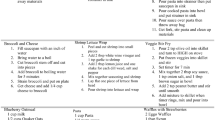Abstract
After more than three decades of studies, video is still a vaguely understood medium for training. In this study, self-modeling (self-observation of videotapes that show only adaptive behavior) was compared with videotaping only, using a within-subject type of design. Subjects were 18 boys and girls aged 5 to 13 years with various disabilities including cerebral palsy and spina bifida. Each child was assigned two target behaviors for potential intervention. One behavior was treated with video self-modeling and the other was videotaped without further intervention, resulting in a significant treatment effect. Self-model recordings were produced by planning and selectively editing two minutes adaptive-oly behavior, which subjects reviewed on six occasions over two weeks for a total of 12 min intervention. Progress was confirmed one year later. The study supports the efficacy of self-modeling for selected behaviors of these children with physical disabilities, and suggests further investigation of structured video replay as an active agent of change.
Similar content being viewed by others
References
Bandura, A. (1994).Self-efficacy: The Exercise of Control, Freeman, New York.
Batshaw, M. L., and Perret, Y. M. (1992).Children with Disabilities: A Medical Primer (third edition), Paul H. Brookes, Baltimore, MD.
Cavaiuolo, D., and Gradel, K. (1990). The effects of distributed feedback and videotape self-monitoring on the productivity of a janitorial trainee with mental retardation.Res. Devel. Disabil. 11: 327–340.
Creer, T. L., and Miklich, D. R. (1970). The application of a self-modeling procedure to modify inappropriate behavior: A preliminary report.Behav. Res. Ther. 8: 91–92.
Dowrick, P. W. (1978). Suggestions for the use of edited video replay in training behavioral skills.J. Pract. Approach. Devel. Handicap 2: 21–24.
Dowrick, P. W. (1979). Single dose medication to create a self-model film.Child Behav. Ther., 1: 193–198.
Dowrick, P. W. (1983). Video training of alternatives to cross gender behaviors in a 4-year-old-boy.Child Fam. Behav. Ther. 5: 59–65.
Dowrick, P. W. (1986).Social Survival for Children: A Trainer's Resource Book, Brunner/Mazel, New York.
Dowrick, P. W. (1991).Practical Guide to Using Video in the Behavioral Sciences, Wiley Interscience, New York.
Dowrick, P. W., and Dove, C. (1980). The use of self-modeling to improve the swimming performance of spina bifida children.J. Appl. Behav. Anal. 13: 51–56.
Dowrick, P. W., and Hood, M. (1978). Transfer of talking behaviors across settings using faked films. In Glynn, E. L., and McNaughton, S. S. (eds.),Proceedings of the New Zealand Conference for Research in Applied Behavior Analysis, University of Auckland, Auckland.
Dowrick, P. W., and Hood, M. (1981). A comparison of self-modeling and small cash incentives in a sheltered workshop.J. Appl. Psychol. 66: 394–397.
Dowrick, P. W., and Raeburn, J. M. (1977). Video-editing and medication to produce a therapeutic self-model.J. Consult. Clin. Psychol. 45: 1156–1158.
Hersen, M., and Bellack, A. S. (eds.). (1988).Behavioral Assessment: A Practical Handbook (third edition), Pergamon, Elmsford, NY.
Holmbeck, G. N., and Lavigne, J. V. (1992). Combining self-modeling and stimulus fading in the treatment of an electrively mute child.Psychotherapy 29: 661–667.
Hops, H. (1982). Social skills training for socially withdrawn/isolated children. In Karoly, P., and Steffen, J. J. (eds.),Improving Children's Competence, Lexington Books, Lexington, MA.
Hosford, R. E., and Polly, S. J. (1976).The Effect of Vicarious Self-Observation on Teaching Skills (Tech. Rep. Contract No. 8-407674-07427), University of California, Innovative Teaching Project, Santa Barbara.
Johnson, M. E. (1989). Effects of self-observation and self-as-model on counselor trainees' anxiety and self-evaluations.Clin. Supervisor 7: 59–70.
Kagan, N. I., and Kagan, H. (1991). Interpersonal process recall. In Dowrick, P. W. (ed.),Practical Guide to Using Video in the Behavioral Sciences, New York, Wiley Interscience, pp. 221–230.
Kazdin, A. E. (1992).Research Design in Clinical Psychology (second edition), Allyn & Bacon, Needham Heights, MA.
Kehle, T. J., Clark, E., Jenson, W. R., and Wampold, B. E. (1986). Effectiveness of self-observation with behavior disordered elementary school children.School Psychol. Rev. 15: 289–295.
Kehle, T. J., Owen, S. V., and Cressy, E. T. (1990). The use of self-modeling as an intervention in school psychology: Case study of an elective mute.School Psychol. Rev. 19: 115–121.
Kenny, D. A. (1987).Statistics for the Social and Behavioral Sciences, Little, Brown & Co., Boston.
Krantz, P. J., MacDuff, G. S., Wadstrom, O., and McClannahan, L. E. (1991). Using video with developmentally disabled learners. In Dowrick, P. W. (ed.),Practical Guide to Using Video in the Behavioral Sciences, Wiley Interscience, New York, pp. 256–266.
Meharg, S. S., and Woltersdorf, M. A. (1990). Therapeutic use of videotape self-modeling: A review.Advan. Behav. Res. Ther. 12: 85–99.
Morgan, R. L., and Salzberg, C. L. (1992). Effects of video-assisted training on employment-related social skills of adults with severe mental retardation.J. Appl. Behav. Anal. 25: 365–383.
Scraba, P. J. (1989).Self-modeling for teaching swimming to children with physical disabilities, Unpublished doctoral dissertation, University of Connecticut, Storrs, CT.
Shear, S. M., and Shapiro, E. S. (1993). Effects of using self-recording and self-observation in reducing disruptive behavior.J. School Psychol. 31: 519–534.
Siegel, S. (1956).Nonparametric Statistics for the Behavioral Sciences, McGraw-Hill, New York.
Stevens, S. S. (1968). Ratio scales of opinion. In Whitla, D. K. (ed.),Handbook of Measurement and Assesment in Behavioral Sciences, Addison-Wesley, Reading, MA.
Author information
Authors and Affiliations
Rights and permissions
About this article
Cite this article
Dowrick, P.W., Raeburn, J.M. Self-modeling: Rapid skill training for children with physical disabilities. J Dev Phys Disabil 7, 25–37 (1995). https://doi.org/10.1007/BF02578712
Issue Date:
DOI: https://doi.org/10.1007/BF02578712




